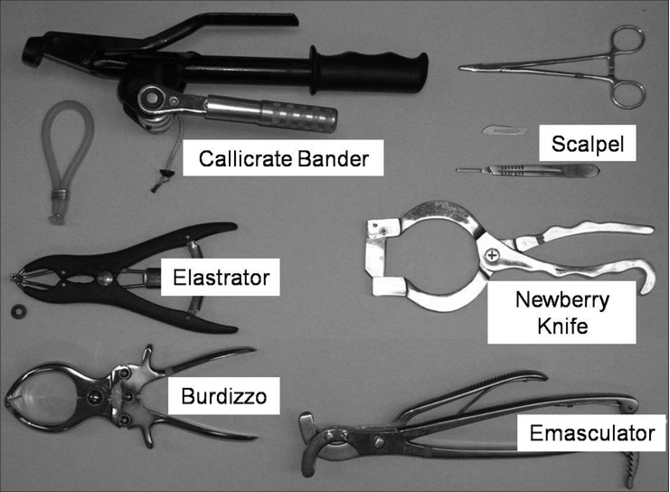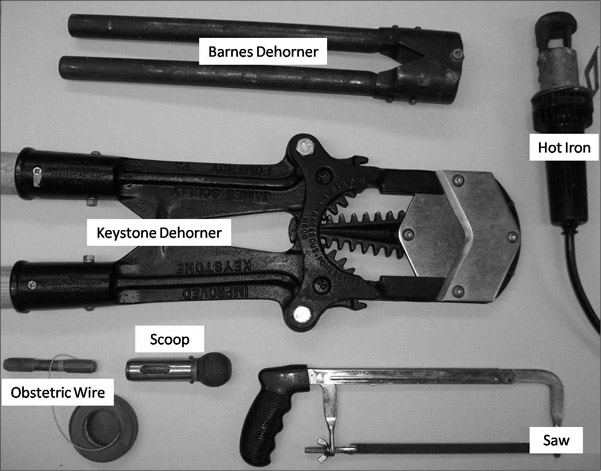Beef Calf Preconditioning Programs
Preconditioning programs are implemented around weaning time. Preconditioning typically consists of weaning calves at least 45 days before a sale, training calves to eat feed from a bunk and drink from a water trough, and following an appropriate vaccination program. It should also include castrating bull calves and ensuring that horned cattle are dehorned or tipped back to the hairline (the animals should have time to fully heal).
Effective preconditioning programs increase the value of weaned calves by promoting calf growth, enhancing immune system function, and minimizing calf stress. Demand for preconditioned feeder calves continues to increase in the beef industry. This demand has grown along with the expansion of value-based marketing and information flow.
Preconditioning requires more labor, management, and expense for cow-calf producers. However, it also offers potential advantages, like developing a reputation for high-quality cattle, adding value to home-raised calves, and increasing income through retained ownership. Producers planning to retain ownership of calves through the stocker phase may also benefit from preconditioning management practices.
Markets for Preconditioned Calves
Target Markets
Start by identifying target markets for preconditioned feeder calves. Marketing alternatives may develop over time as a producer’s reputation and quality of cattle become more widely known. Some producers develop relationships directly with cattle buyers, while others participate in organized feeder calf marketing efforts with other producers. For more information on feeder calf marketing alternatives, see Extension Publication 2552 Marketing Feeder Calves.
Requirements differ among various preconditioned feeder calf sales, and documentation of preconditioning practices may be necessary. It is important to know a program’s specific requirements to qualify calves for sale. Acceptable documentation may include herd health product or veterinary invoices or receipts, calf weaning records, and completed certification forms.
Preconditioning program guidelines often include ownership requirements. Often, a producer must have owned a set of calves for a minimum time in order for them to qualify for the program. Individual calf identification is critical for proper record-keeping and can be accomplished in several ways. Unique ear tags are a common form of identification, but because ear tags can be lost, some producers choose to permanently identify cattle using tattoos or brands.
Preconditioning Cost-Effectiveness
Preconditioning requires more time, labor, and expense than traditional weaning programs. It must be profitable so producers will want to retain calves through a preconditioning period. Some producers feel the buyer receives most of the benefits and cow-calf producers are not adequately compensated for the added value. However, Mississippi feeder calf board sale results show that, if cattle are marketed in a way that advertises the management they received, they will bring a premium over the average market price.
Develop a budget before deciding to implement a preconditioning program. Estimate expected costs, returns, and production levels, and then monitor them throughout the preconditioning period. To be profitable, producers must keep cost of gain to a reasonable level while providing a nutritional program that produces acceptable weight gains. A reasonable feed cost of gain must be lower than breakeven feed cost of gain to be profitable.
Manage veterinary and other health costs for profitable preconditioning. The cost-effectiveness of a preconditioning program varies according to market and production conditions. Weight gains alone may not offset feed and overhead cost. In cases where added returns from weight gains alone do not cover preconditioning costs, calves must return an adequate premium at sale for preconditioning to be profitable.
Weaning
Wean calves at least 45 days before a sale or according to the requirements of the specific preconditioning program. Weaning is extremely stressful. Use techniques that minimize calf stress during this time to improve health and growth performance. Stress at weaning can increase the likelihood of calves developing respiratory infections.
Sorting and hauling freshly weaned calves to the sale facility the day before the auction can result in increased shrink compared to preconditioned calves. Preconditioning calves can minimize shrink and add additional sale weight. Additional stress results when calves are introduced to unfamiliar surroundings post-weaning. Give calves access to the weaning area a few days before weaning. Corrals, drylots, or small pastures can serve as weaning facilities. Good fences will prevent calves from returning to their mothers to nurse. Small lots may reduce fence walking or pacing, but dust or mud can become problems in dry or wet conditions.
Fenceline weaning, where calves remain in sight of and close to their mothers, may reduce weaning stress. Cows will graze close to their calves, gradually moving farther away during the days after weaning. One weaning technique involves initial nose-to-nose contact between cows and calves, followed by gradual increases in separation distance by moving electrified wires or tapes farther from each side. Train cattle to respect electric fencing before weaning to facilitate the process.
Fenceline weaning also allows high-quality pastures to be used as weaning facilities instead of dusty drylots. Allow calves to creep-graze into these high-quality pastures before weaning to give them time to become familiar with their surroundings. Close the creep gate at weaning. Fenceline contact with dams minimizes losses in weight gain in the days following separation. Calves totally and abruptly separated from their dams do not compensate for losses in weight gain even by 10 weeks post-weaning. Properly weaned calves are “bawled out” and readily consuming feed and water well before the preconditioning period ends.
Preconditioning Nutrition Programs
The profitability of a preconditioning program depends largely on calf weight gains during the pre-conditioning period. The nutrition program makes up the majority of the preconditioning budget, and adequate weight gains are needed to recover these costs. Producers must choose the nutritional approach that best meets rate of gain and budget targets. Decisions on a desired rate of gain might involve:
- achieving delivery weight targets
- optimizing cattle condition
- minimizing digestive disorders and disease risk
- obtaining reasonable cost of gain
- marketing home-raised feedstuffs through the pre-conditioning program
- optimizing labor and equipment investment
Rate of gain falls into general categories: low average daily gains (less than 1.5 pound per day), moderate average daily gains (1.5 to 2.5 pounds per day), or high average daily gains (greater than 2.5 pounds per day). A low rate of gain may be desired when cattle will enter stockering programs with low levels of nutrition or where potential buyers may discount overly fleshy calves. When cattle are destined for high-quality pasture or feedlot programs, higher rates of gain may be appropriate.
Calves typically lose weight in the first week after weaning but will often regain that weight within 2 weeks. Health, stress, previous nutrition, diet composition and quality, feed additives, and implants impact weight gains. The benefits of a concentrate (grain-based) feeding program include:
- supplies calves with the needed dietary nutrient density
- facilitates delivery of feed additives such as ionophores and coccidiostats
- teaches eating from a feed bunk
- makes health monitoring easier
Feeding at least once daily forces producers to observe cattle often and may help identify cattle feeding behaviors that indicate health problems, such as sudden changes in appetite or reluctance to feed.
Preconditioning feeds need to be highly palatable and nutrient-dense with minimal fines and dust. Familiarity with specific feedstuffs or exposure to feeds before weaning (creep feeding) can encourage consumption. These feeds should contain protein from natural sources and adequate amounts of key minerals and vitamins including copper, zinc, selenium, potassium, and vitamin E.
An effective nutritional program provides a desirable level of growth performance during the preconditioning period. Consider feedstuff availability and cost when developing feed supplementation programs. Design economical nutrition programs around forage systems. Forage nutrient analysis is critical for determining forage quality and matching a supplementation program to the forage program. Using forage nutrient analysis results to balance a diet helps ensure that calf nutrient needs will be met.
Design supplementation programs to target specified levels of weight gain. Because nutrient requirements change with increasing body weight, measure weights throughout the preconditioning period to accurately estimate nutrient requirements. Calves weighing less than 400 pounds warrant special feeding considerations.
Feed Bunk and Water Trough Training
During weaning, calves must transition from a milk diet to forage- and concentrate-based diets. Calves that have used feeding bunks and water troughs before weaning may go on feed faster after weaning. Some calves leave the ranch having never seen a feed bunk or water trough.
Take specific steps to train calves to use a feed bunk or watering trough.
- Remove water until calves fill up on hay.
- Cattle may drink faster if they can hear the water, so use a temporary drip system.
- Small troughs that are frequently refilled with cool, clean water are often more attractive to calves during hot weather than larger troughs containing warmer water.
- Position feed bunks perpendicular to fence lines so calves will find the feed bunk faster when they walk the fence.
- Make feed bunks and water troughs highly visible and accessible.
- Provide adequate bunk space (at least 18 to 24 linear inches per head) to prevent crowding.
- Give calves access to clean water and adequate mineral supplements at all times.
Weigh feed to ensure accurate feed offerings. To keep cattle consuming consistent feed quantities each day, do not increase feed until feed bunks are completely emptied 2 days in a row. Likewise, do not decrease the feed amount unless 25 percent or more of the feed remains. Never increase or decrease the feeding amount by more than 10 percent at once. Feed cattle and observe feed bunks at the same time each day for accurate bunk management.
Management Practices to Improve Calf Value
Calf Uniformity
Using a controlled calving season results in calves of similar age at preconditioning time. This also facilitates the feeding program. Groups and load lots of uniform calves command market premiums by reducing transaction expenses for buyers to fill orders. Age of the calf is not the only factor in uniformity. Also consider weight, frame size, sex, and hide color.
Uniform calf age also can make it easier to age-, source-, and process-verify a group. Age-, source-, and process-verification require a third-party evaluation of herd records such as calving dates, tagging procedures, and management and production records. This verification is required for some export markets. Verified cattle sometimes bring premiums because they are competing in smaller markets and have a higher demand.
Castration
Although bulls typically gain faster than steers, most feeders are not interested in feeding bulls. Steers with growth implants typically produce gains similar to those of intact bulls. Castration reduces behavioral problems and prevents unwanted pregnancies in post-weaning production programs. If weaned bull calves are sold, the cow-calf producer pays the next owner to castrate the calves via discounts for intact bull calves. According to a 2005 Arkansas livestock auction survey, bulls were discounted $6.27 per hundredweight on average compared to steers. A 2009 USDA NAHMS survey of cow-calf management practices revealed that 25.5 percent of operations did not castrate bull calves before they were sold.
Castration becomes increasingly stressful as bulls get older. Younger bulls experience less bleeding, infection, and weight-gain depression than older bulls. Calves castrated later in life may exhibit an undesirable “staggy” appearance. Seedstock producers often wait until weaning to decide which bull calves to castrate and which to develop as future breeding stock.
In a commercial cow-calf operation, castrate bull calves as early in a calf’s life as possible. Restraining and handling younger calves is easier than working older, larger bulls. An ideal time to castrate nursing bull calves is during the first 36 hours of life.
Many producers prefer to wait and castrate large groups of calves at once. In this case, all calves should be castrated at 3 months of age or earlier. To reduce infection risk, avoid castration during fly season and on wet days when the calf may lie in mud. Table 1 lists various castration methods, and Figure 1 shows castration equipment.
|
Castration Method |
Instruments |
Procedure |
Advantages |
Disadvantages |
|---|---|---|---|---|
|
Surgical |
Newberry knife, scalpel, emasculator |
Open the skin of the scrotum with large incisions or removal of the bottom third of the scrotum to promote adequate drainage. Grasp and slowly pull the testicles downward until the spermatic cord muscle separates. Do not “dig” for the testicles. In young calves, pull out the testicles until the cord breaks. In older calves, use emasculators to crush the spermatic cord or a dull knife to scrape the cord in a shaving motion. Do not cut the cord, because excessive bleeding may occur. Treat wounds with fly repellant. Release surgically castrated calves to a clean, dry area. |
Certainty of complete castration |
Blood loss
Infections may result if there are drainage problems or irritation from flies.
Slower to perform than banding
|
|
Emasculatome |
Burdizzo, clamps |
Move one testicle to the bottom of the scrotum. Locate the spermatic cord above the testicle, and move it to the side of the scrotum. Place the emasculatome over the cord about two inches above the testicle. Pinch the spermatic cord through the skin of the scrotum. The instrument should be one-third of the way across the width of the scrotum and never across the middle of the scrotum. The cord should snap apart. Hold the instrument with jaws closed for 30 seconds. Double clamping can increase success rate.
|
Bloodless
Used for older, larger calves |
Slow, difficult
Sometimes unreliable (stags)
Emasculatomes eventually wear out and become ineffective. Do not store an emasculatome in the closed position. |
|
Banding |
Elastrators, EZE, Callicrate banders
|
Place the band on the instrument and press the handles to stretch the band. Hold with the prongs pointed upward. Close the handles to open the band. Slip the band up and over the scrotum. Make sure both testicles are below the band. Allow the band to close on the neck of the scrotum. Pull the instrument out from under the band. Repeat if not done correctly. Administer tetanus and blackleg shots well before banding.
|
Bloodless
Used for older, larger calves
Easy to perform; newer banders adjust bands to proper tension levels |
Potential for missed testicles
Band may break or not cut off all circulation to testicles
Infections (tetanus, Clostridial) |

Dehorning
Cattle buyers discount calves with horns. Results from a 2005 Arkansas livestock market survey indicate that polled or dehorned feeder calves sold for an average of $3.70 per hundredweight more than horned cattle. Horn-related injuries may occur during shipping and in the feedlot, so cattle feeders prefer dehorned calves.
A 2009 USDA NAHMS survey of cow-calf management practices determined that only 49.7 percent of horned calves in the Southeast United States were dehorned before being sold. The national average was 61.1 percent. The average age for dehorning was 130 days. Results of the 2005 National Beef Quality Audit indicate that 22.3 percent of cattle evaluated on the harvest floor had horns, down from 32.2 percent in 1995.
One way to produce calves without horns is to use a homozygous polled herd sire. Several options are also available for physically removing horns from cattle (Table 2). Dehorning methods differ by animal age and stage of horn development. Horn tissue is formed in specialized cells in a small ring around the horn button. Perform bloodless dehorning methods before significant horn growth to destroy this ring of cells.
Mechanical dehorning can be performed at any age or animal size. It involves physically removing the horn, along with a small ring of skin surrounding it. Minimize stress and complications by dehorning at a young age, preferably younger than 1 month.
Use sharp, disinfected dehorning instruments when dehorning adult cattle (Figure 2). Because damaged bone tissue may be more susceptible to infection, cut bone tissue rather than crushing it. Problems with infection are rare, except in situations where dehorning leaves an opening into the sinuses.
Use disinfectants on dehorning instruments to prevent wound infections and the spread of infectious diseases. Dehorn outside of fly season to reduce infection. Treat wounds with blood coagulant powder and fly deterrent.
As with castration, ensure that calves are properly restrained for physical dehorning. Dehorning requirements for preconditioning programs may involve complete dehorning or only tipping horns back to the hairline. In either case, dehorned calves should be fully healed before shipment.
|
Dehorning Method |
Procedure |
Advantages |
Disadvantages |
|---|---|---|---|
|
Chemical |
Apply caustic paste to horn button at 1 day to 3 weeks of age. Cut hair from around horn button before application. Apply petroleum jelly around the area of caustic paste application to minimize chemical burns. Keep the calf separated from its dam until the paste has dried.
|
Works well on young calves
Bloodless |
Caustic paste application before a rain can cause eye injury |
|
Hot iron |
Heat irons with fire or electricity. Place hot iron over the horn and hold in place with firm pressure. Twist the iron evenly to distribute heat. Apply long enough (usually 20 seconds) to kill all horn cells at the base. The skin should appear copper or bronze. If not, reap- ply for 10 seconds. |
May use after the horn button appears up to 4 months of age
Works best in calves younger than 2 months of age with less than 1 inch of horn growth
Bloodless |
Must be done when calves are young and horns are small
|
|
Tube or spoon dehorners |
Cut around the horn and surrounding skin and scoop out. |
Effective on very small horns less than 11/2 inch long
Multiple intstrument sizes available |
Not bloodless |
|
Barnes dehorners |
Select an instrument size large enough to remove the horn and a ¼- to ½-inch circle of skin at the horn base. Press the instrument firmly against the calf’s head. Quickly open and twist the handles. Stop any bleeding by cauterizing with a hot iron or pulling arteries with forceps.
|
May use on calves up to or slightly past weaning
Multiple instrument sizes available |
Not bloodless |
|
Saws, wires, keystone dehorners |
Remove a ½-inch circle of skin along with the horn base to prevent regrowth. Stop any bleeding by cauterizing with a hot iron, pulling arteries with forceps, or using coagulant powder. Observe the wound for infection for an extended period of time. |
For use in older cattle with large horns |
Not bloodless
Exposed sinus may become infected |

Preconditioning Health Programs
Value to Cattle Buyers
Preconditioned calves have fewer post-weaning health problems. Data from the Mississippi Farm to Feedlot Program and similar programs in surrounding states demonstrate the dramatic effects of health and medicine costs on cattle finishing profitability. Mississippi Farm to Feedlot Program results indicate that sickness in the feedlot reduces a calf’s ability to grade USDA Choice.
A 2001 USDA-APHIS study of U.S. feedlots with at least a 1,000-animal capacity found 14.4 percent of cattle were affected with bovine respiratory disease. The associated treatment cost was estimated at $12.59 per animal. In a 2007 survey, APHIS reported that 60 percent of cow-calf operations did not vaccinate calves for respiratory disease before selling them.
Certain buyers are willing to pay premiums for preconditioned calves. This is because they understand the extra cost of a preconditioned calf may be more than offset by reduced sickness, lower medicine costs, decreased labor requirements, improved performance, and enhanced beef quality. Three years of data on 56,000 head of calves sold in the Oklahoma Quality Beef Network program (with known health and preconditioning protocols) demonstrate buyers’ willingness to pay $5.85 more for preconditioned calves. More recent marketing programs in Mississippi (the Homeplace Producers’ and Cattlemen’s Exchange board sales) also demonstrate a significant increase in the value of preconditioned feeder calves sold in truckload lots.
Vaccinations
If the chosen market outlet does not specify a vaccination program, consult with a veterinarian to design a preconditioning vaccination protocol. Some producers choose to vaccinate calves 2 to 4 weeks before weaning and administer booster injections at weaning. Other producers administer the first vaccines at weaning with boosters administered 2 to 4 weeks after the initial injections. Some vaccines can be purchased in combination to reduce the number of injections.
Know the required vaccination protocol and specifications of the targeted preconditioning sale. Many preconditioned calf sales require individual identification. Many also require a licensed veterinarian’s certification of health and vaccination program. Some will accept certification through receipts for animal health products along with producer affidavits. Some sales may require heifers to be vaccinated against bruscellosis (Bang’s or calfhood vaccinations).
Parasite Control
Treat calves with a deworming product to manage parasite loads. Ideally, treat for internal and external parasites at the same time. Many pour-on and injectable products will treat internal parasites as well as lice, mange mites, and horn flies.
Beef Quality Assurance Training
The Mississippi Beef Quality Assurance (BQA) program educates producers about breeding and management factors that affect beef quality. Many producers promote BQA certification when marketing their calves. While BQA certification may not be a requirement of some preconditioned sales, it can add value to calves. The Mississippi BQA certification process is voluntary and certifies cattle producers instead of individual animals.
Summary
Preconditioned feeder calves should be healthy, adapted to feed and water, castrated, dehorned, and ready to start eating and gaining weight when they arrive at the stocker operation or feedlot. Properly preconditioned calves may command a premium that more than pays for the cost of the preconditioning program. Yet under certain conditions, preconditioning may not be cost-effective.
Management strategies can improve the chances for profitable preconditioning. These include the following:
- dehorning and castrating at a young age instead of near weaning
- minimizing weaning stress
- getting calves onto feed and water rapidly
- implementing effective and economical nutrition and herd health programs
Although cost-effectiveness of preconditioning varies with market fluctuations and input costs, the potential benefits to the cattle buyer remain. Know what it costs to precondition a set of calves to determine if precon- ditioning is an attractive marketing option.
A successful preconditioning program maintains a reasonable cost of gain and utilizes a market that is willing to pay for the added value. These management techniques can increase calf value and are vital to an effective preconditioning program:
- Limit stress at weaning by effectively managing castration, dehorning, and weaning strategies.
- Develop a nutritional program based around on-farm forage resources targeting a desired rate of gain at a sensible cost.
- Implement proper vaccination and other herd heath management practices.
For more information on calf preconditioning or related topics, contact your local MSU Extension office.
References
APHIS. 2001. Treatment of respiratory disease in U.S. feedlots. October 2001 Information Sheet. Animal and Plant Health Inspection Service. United States Department of Agriculture. Fort Collins, CO.
Barham, B. L., & Troxel, T. R. (2005). Factors affecting the selling price of feeder cattle sold at Arkansas livestock auctions in 2005. Journal of Animal Science, 85, 3434–3441.
Barnes, K., Smith, S., & Lalman, D. (1999). Managing shrink and weighing conditions in beef cattle. Oklahoma Cooperative Extension Service. F-3257. Stillwater, OK.
Lalman, D., Gill, D., Highfill, G., Wallace, J., Barnes, K., Strasia, C., & LeValley, B. (2002). Nutrition and management considerations for preconditioning home raised beef calves. Oklahoma Cooperative Extension Service. F-3031. Stillwater, OK.
NAHMS. (2009). Reference of beef cow-calf management practices in the United States, 2007–08. National Animal Health Monitoring System. Veterinary Services, Animal and Plant Health Inspection Service. United States Department of Agriculture.
NCBA. (2005). National beef quality audit. National Cattlemen’s Beef Association. Denver, CO.
Pate, F. M., & Crockett, J. R. (2002). Value of preconditioning beef calves. University of Florida Extension. Institute of Food and Agricultural Sciences. Bulletin 799. Gainesville, FL.
Price, E. O., Harris, J. E., Borgwardt, R. E., Sween, M. L., & Connor, J. M. (2003). Fenceline contact of beef calves with their dams at weaning reduces the negative effects of separation on behavior and growth rate. Journal of Animal Science, 81, 116–121.
Yates, W. D. G. (1982). A review of infectious bovine rhinotracheitis, shipping fever pneumonia, and viral-bacterial synergism in respiratory disease of cattle. Canadian Journal of Comparative Medicine, 46, 225.
Publication 2578 (POD-12-23)
Reviewed by Brandi Karisch, PhD, Associate Extension/Research Professor, Animal and Dairy Sciences. Written by Jane A. Parish, PhD, Professor and Head and Interim Head, North Mississippi Research and Extension Center; Justin D. Rhinehart, former Assistant Extension Professor, Animal and Dairy Sciences; and Holly T. Boland, former Assistant Research/Extension Professor, Prairie Research Unit.
The Mississippi State University Extension Service is working to ensure all web content is accessible to all users. If you need assistance accessing any of our content, please email the webteam or call 662-325-2262.




